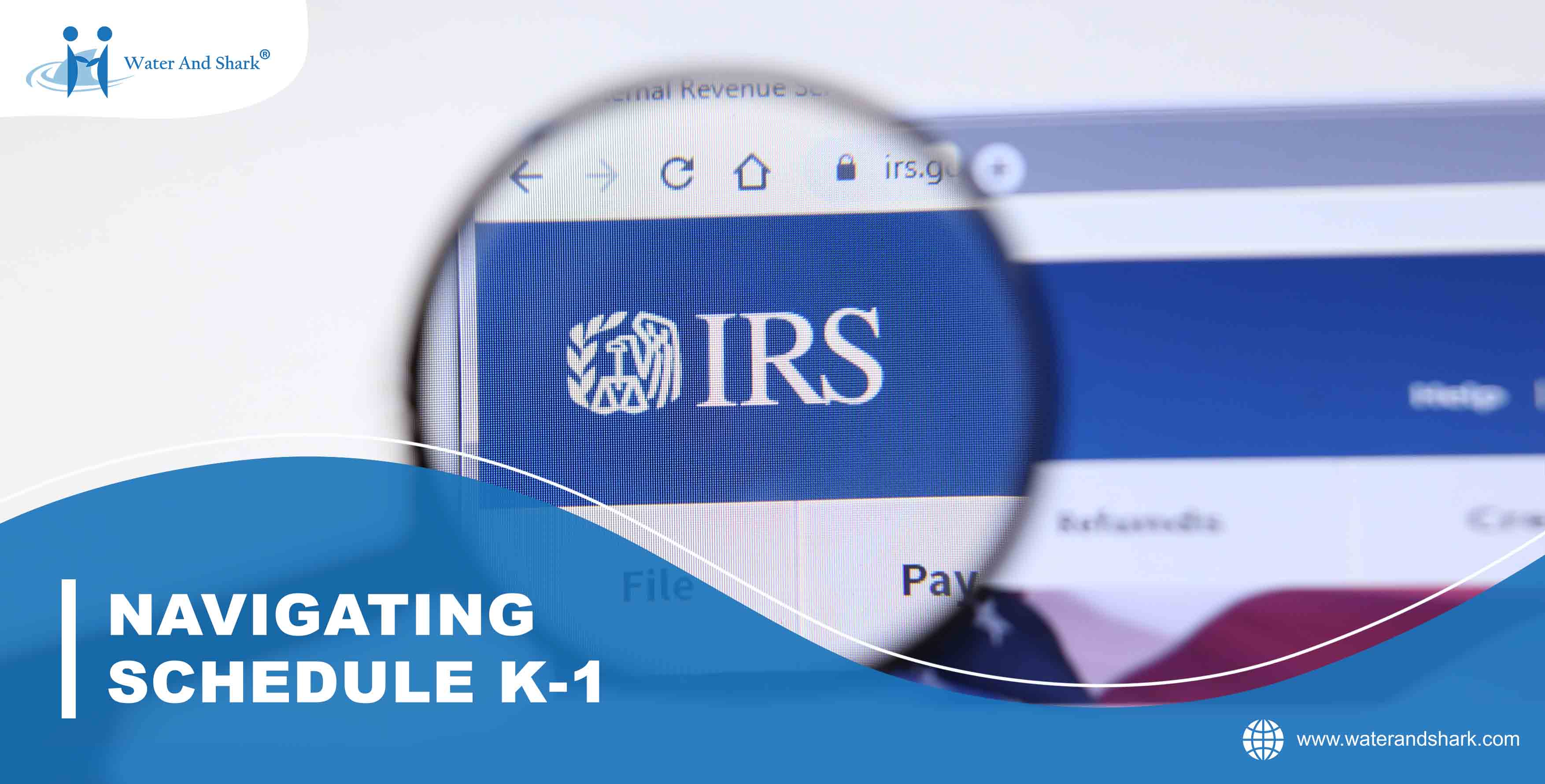NAVIGATING SCHEDULE K-1: ESSENTIAL GUIDELINES FOR US PASS THROUGH ENTITIES
March 31, 2024 waterandshark
Schedule K-1 is a breakdown of your portion of the financial activity from the entity you have ownership in, which you use to accurately report your income or losses on your individual tax return. When the entity you're involved with generates income or experiences losses, that financial activity gets divided among the owners or investors based on their ownership percentage or other agreed-upon arrangements.
Usually, K-1 is issued by pass-through entities. Pass-through entities like partnerships and S-corporations don't pay taxes themselves. Instead, they pass their tax obligations to their owners or beneficiaries. Thus, Schedule K-1 is a form issued by these entities to their beneficiaries, showing their share of income, deductions, and other tax items, which the beneficiaries then report on their personal tax returns.
Entities considered as pass through entities in the USA:
- Business Partnerships
- S corporations
- Trusts and Estates
- LLCs electing to be taxed as S Corp or Partnership
Jump right in:
Entity-wise requirements and contents of Schedule K-1
Filing Schedule K-1?
Entity-wise deadline to file Schedule K-1
FAQs
Entity-wise requirements and contents of Schedule K-1
Business Partnerships:
Partnership is a business structure where two or more individuals share ownership and responsibilities, with profits and losses allocated based on partnership agreements. A partnership files Form 1065, an annual information return, to report its financial activity, including income, deductions, gains, and losses. As a pass-through entity, the partnership itself doesn't pay taxes; instead, partners do. Therefore, the partnership provides each partner with Schedule K-1.
Schedule K-1 provides essential details about a partnership, including information about individual partners. It includes each partner's share in the partnership, their capital contributions, and balances at the beginning and end of the year. Additionally, it outlines their portion of income or losses from various sources like ordinary business, interest, dividends, and capital gains. It also covers any guaranteed payments and specific deductions according to predefined agreements.
S-Corporations:
An S-Corp is a business structure similar to a partnership and an LLC, functioning as a pass-through entity where shareholders are not personally liable for the entity's debts. Income reporting for an S-Corp is done through Form 1120-S. Similar to partnerships, tax liabilities are passed on to shareholders. Consequently, S-Corps provide shareholders with Schedule K-1 to aid in filing individual income tax returns using Form 1040.
Schedule K-1 comprises essential details about both the entity and the specific shareholder, including the shareholder's end-of-year share count, any loans received from shareholders, and their share in the corporation's income or losses. It also itemizes interest, dividend, and royalty income, as well as capital gains or losses, and deductions received by the entity. These amounts are allocated to the shareholder based on their proportionate ownership of shares.
LLCs elected to be taxed as S-Corp or Partnership:
LLCs have a hybrid business structure which comprises of the characteristic of both corporations as well as partnerships. The structure aims to protect the owners from their personal liability for the debts of the company. LLCs enjoys a pass-through status wherein the entity does not pay the tax on the income from business if it elects to be treated as a partnership or an S-Corp.
If LLC elects to be treated as a partnership, form 1065 should be filed and if it elects to be treated as a corporation, Form 1120 or 1120-S is to be filed with the authorities. Not all the LLCs have to issue schedules K-1 along with the forms. Only LLCs opting to be elected as S-Corp or Partnership have to issue Schedule K-1.
Trusts and Estates:
Trusts and estates are key legal structures for passing on assets to heirs and beneficiaries. Estates transfer assets once after death, while trusts enable continuous asset transfer both before and after death. An estate or trust are also pass-through entities, where income isn't taxed at the entity level but passed through to individual beneficiaries for taxation at their rates. Trust income can be interest, dividends, or capital gains. The trust document decides who gets what. For taxes, trust and estate income is like individual income, including ordinary income and capital gains. Trusts and estates must issue a Schedule K-1 to beneficiaries.
Schedule K-1 provides essential information about trusts/estates and details the beneficiary's share of income, including interest, dividends, capital gains/losses, rental income, and other portfolio income. It also includes estate tax deductions and credits from the trust or estate
Filing Schedule K-1?
Partnerships, LLCs, S corporations, and Trusts & Estates include Schedule K-1 with their IRS submissions. Individuals filing taxes using Form 1040 can do so through the IRS website or tax software. They report all incomes earned, including those from pass-through entities, such as partnerships or S corporations, under "Other Income." Here, they provide details from their Schedule K-1. The software may allow direct import or require manual entry of Schedule K-1 data. Regardless, including Schedule K-1 details is crucial when filing Form 1040.
Entity-wise deadline to file Schedule K-1
|
Entity |
Due Date |
|
Business Partnership |
15th day of the 3rd month of the financial year end |
|
S-Corporations |
15th day of the 3rd month of the financial year end |
|
LLCs elected as S-Corp or Partnership |
15th day of the 3rd month of the financial year end |
|
Estates and Trusts |
15th day of the 4th month of the financial year end |
FAQs
- Do partners/beneficiaries/shareholders need to pay taxes on the income reported on Schedule K-1?
- How does Schedule K-1 differ from the reporting forms of entities?
- Can Schedule K-1 be amended if errors are discovered after filing?
- Can an extension be obtained for filing schedule K-1?
Yes, partners are required to include the income reported on Schedule K-1 on their individual tax returns (Form 1040) and pay taxes on their share of the respective entity’s income, deductions, and credits.
The reporting forms are tax return that reports the entity's financial details collectively to the IRS, while Schedule K-1 provides individual share of income, deductions, and credits for personal tax reporting.
If you find an error on your Schedule K-1, notify the partnership for a corrected version. Don't modify your copy. Ensure the partnership sends the corrected Schedule K-1 to the IRS for accurate tax reporting.
Schedule K-1 is to be issued along with the form by the respective business entities. Where an entity files an extension for filing the form, the extensions also applies to filing of schedules that accompanies such forms.





Comment